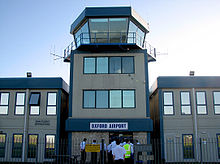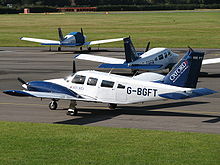- Oxford Aviation Training
-
File:OAAlogo.gif Based: Oxford Airport Website: http://www.oxfordaviation.net Oxford Aviation Academy (Oxford) Ltd., known as Oxford Aviation Training prior to February 2008, is a commercial pilot training school based at Oxford Airport in the United Kingdom and Phoenix Goodyear Airport in the United States.
Contents
History
 The Air Traffic Control tower at Oxford Airport.
The Air Traffic Control tower at Oxford Airport.
Oxford Flying Club was officially opened by the Mayor of Oxford in 1939. However, restrictions placed on civil aviation during World War II curtailed its activities and the airfield operated as RAF Kidlington for the duration of hostilities. The club reopened in 1947, renamed as the Oxford Aeroplane Club. During the 1950s it gradually increased its fleet and, by 1960, had become a flying school geared to the training of professional pilots.
In 1961, the flying school's parent company, Oxford Aviation, merged with the Pressed Steel Company to become British Executive Air Services Ltd. (BEAS). Dedicated ground school buildings and student residential accommodation were provided on site, and the first fully integrated Commercial Pilot's Licence and Instrument Rating courses began in May 1962.
In 1963, the BEAS Flying Training Division was renamed Oxford Air Training School. Since then, over twenty thousand trained commercial pilots and aircraft engineers have graduated from the school. The school changed its name to Oxford Aviation Training (OAT) in the 1990s.
On 19 June 2007, OAT's parent company BBA Aviation Group sold OAT to GCAT Flight Academy (formerly General Electric Commercial Aviation Training, part of General Electric and SAS Flight Academy, part of Scandinavian Airlines System) for $63 million (£32 million). The deal was backed by GCAT Flight Academy's majority shareholder, STAR Capital Partners an independent venture capital fund.
In early February 2008, GCAT Flight Academy changed its registered name to Oxford Aviation Academy Ltd. Oxford Aviation Training Ltd. changed its registered name to Oxford Aviation Academy (Oxford) Ltd. OAT's branding and logo adorning the training centre at Oxford and Goodyear Airports were replaced, with the new logo bearing the title 'Oxford Aviation Academy'. The insignia on the tailplanes of its Piper PA-28 Warrior and Piper PA-34 Seneca aircraft were also replaced with the new logo design. The new logo also appeared at the 8 locations formerly named GCAT Flight Academy, including those in Scandinavia and Hong Kong that GCAT purchased from SAS Flight Academy and the Woodford Training Center purchased from BAE Systems. These changes were a result of both GCAT Flight Academy and Oxford Aviation Training being re-branded as Oxford Aviation Academy. The new Oxford Aviation Academy website was launched on 4 February 2008: http://www.oaa.com though the old http://www.oxfordaviation.net website is still active. Most of the links at http://www.oaa.com in the ab-initio pilot training section redirect to pages at http://www.oxfordaviation.net.
Fleet
An OAT Piper PA-34 Seneca at Oxford Airport
Oxford Aviation Academy (Oxford) Ltd. has a fleet of aircraft and simulators based in the UK and in the USA.
Aircraft Fleet Seats Engine Piper PA-28 Warrior 32 4 Single Piston Piper PA-34 Seneca 22 6 Twin Piston Socata TB20 Trinidad 2 4 Single Piston Zlin 242L 1 2 Single Piston Simulator Fleet Engine Piper PA28/PA34 Dual model 3 Single/Twin Piston Piper PA34 Seneca 4 Twin Piston PC Desktop Trainers 12 Twin Piston Boeing 737-400 2 Twin Jet Canadair CRJ-200 1 Twin Jet APP First Officer
This is a UK CAA Approved full-time JAR-FCL Integrated course of pilot training and is used to train pilots to the level of proficiency necessary to enable them to operate as a Commercial Pilot for airlines flying under JAA/EASA oversight. The course is designed for trainees who have little or no previous flying experience and must be completed at one flight training organisation. Beginning September 2007, in cooperation with Buckinghamshire New University, OAA added a Foundation Degree in Airline Transport Management to the APP First Officer Course. The integrated course syllabus was modified in January 2008, to affect those from AP285 onwards, and now consists of 216 hours of flight training and 760 hours of ATPL(A) theoretical knowledge training and lasts approximately 16 months – culminating in the issue of a JAA CPL with Instrument Rating and Multi-Crew Co-operation credit. Following this course, a pilot is now qualified to seek employment as a First Officer on jet or turboprop aircraft and commence airliner type, base and line training.
External links
Categories:- Aviation licenses and certifications
- Flight training
- Aviation schools
Wikimedia Foundation. 2010.

